| Report Type | Full |
| Peak(s) |
Pico de Orizaba - 18491 |
| Date Posted | 10/17/2015 |
| Modified | 10/19/2015 |
| Date Climbed | 01/07/2015 |
| Author | antivoyage |
| Travelling to the top of Mexico |
|---|
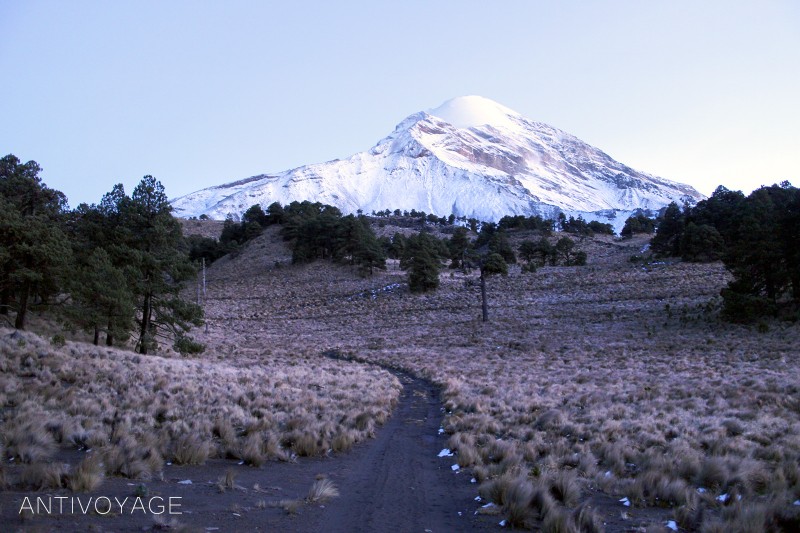 My Story:The days leading up to my departure were marked with an excited nervousness and an increasing number of brown UPS boxes with the list of missing gear showing up at my desk. Wrapping up a final project one evening, the skies cleared and I turned my bike south along the Hudson River to ride through the cold evening lights of the city. I was met at home by an enormous gear bag and a suitcase waiting by the door. I made a final meal of the remaining food in the fridge and hefted bags onto back and on clenched arm and lumbered on to the stoop with light snow drifts adorning the corners, my breath rising in the night to meet bare tree branches. A yellow taxi covered in road grime, engine steaming, interrupted this perfect Northeastern monochromatic tableau and I muscled baggage into the trunk and slid onto an old sofa vinyl bench seat to watch the derelict fringes of Brooklyn and Queens jerk by as we alternately raced and halted down Atlantic Avenue to JFK. There I sipped a beer, observing sari-clad women, southeast Asian men in short sleeved Madras shirts and sandals and throngs of agitated children before being cattle called onto my red-eye to Mexico City, Benito Juarez International. The sounds of mixed Spanish and English greetings from the attendants were an interlude to being someplace else for a while. I read then dosed on this five-hour time capsule that set me in a place very much like the one I'd come from, but jacket now slung over shoulder, I stepped out into a balmy crisp sunshine-filled morning that felt like September or April where I'm from. An old Mathematician friend was there to greet me with a bear hug and this time we picked up a Metrobus that snaked its way into an industrial neighborhood through to the unkempt elegance of downtown. It took just long enough to get through the preliminaries and soon we were out on the cobbled streets. Parched from the jet, it was on this trip that E introduced me to Peñafiel Twist, a seltzer with something like a margarita mix flavor added for fun. The bottle describes it as limon con un toque de sal, or lime with a touch of salt, and odd as it may sound it's one of the commonest seasonings for many Mexican foods and it hit the spot. We meandered through the pedestrian streets that were thronged with people who had come to do their Christmas shopping. It was like wading, myself with the enormous climbing duffel and E, also quite tall, managing my suitcase. We finally popped into Salon Corona where they were just firing up the Pastor spit. We devoured the dish of pickled peppers on the table over a beer and a catch up and ordered another round of mugs over our plates of tiny tacos, each one no larger than the palm of a hand, which makes sense if you think of how they're made. The rest of the day was a sunshiny blur. E's wife joined us for dinner at a revolving restaurant where we watched the mountains around the Valle de Mexico turn golden, with lights of the skyscrapers below flickering on, then pink to complement the warm incandescence of city lights. By desert it was dark skies and glimmering buildings and we'd made a full turn. We hopped a taxi to a Posada party where I met my now girlfriend and then home to E's place. I spent the morning sorting out my backpack swollen with winter coats and E and his wife sent me off with a homey egg breakfast and a Ponche, that they insisted was improper for an adult to drink any other way than spiked. It warmed the belly for a chilly morning walk to the subway that zipped me to TAPO looking like a space alien with my polyester clothing and ice-axe adorned expedition pack. It was my turn to be the foreigner and people definitely stared. 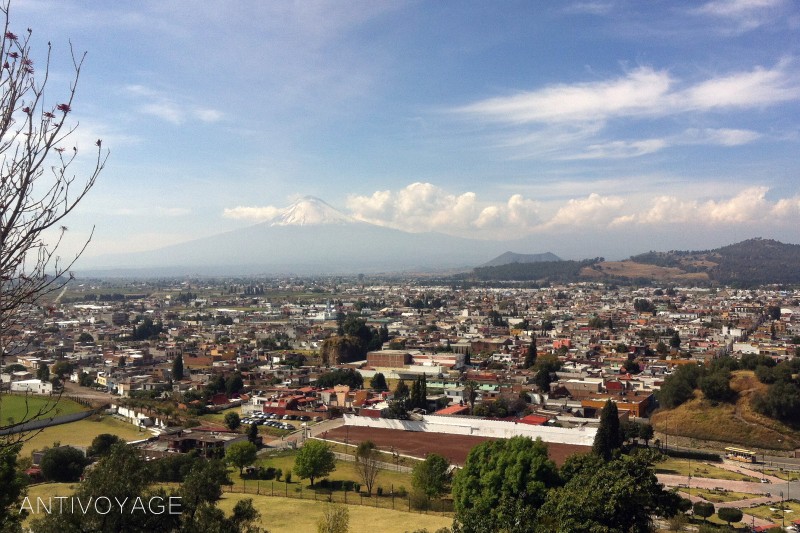 TAPO, the bus terminal was confusing, but surprisingly nice and I was promptly whisked over the saddle between Popocatépetl and Iztaccihuatl to Puebla's CAPU bus station. Again it was confusing and there were exasperatingly long lines because of holiday travelers, but it was direct enough and I caught an older bus at the far wing of one of the two gates bound for Tlachichuca. We sped off through dried and brown cornfields in winter fallow with a diesel rumble. Views were wide with looming mountains hazy on the horizon. I peered out at each indistinct hazy mass on the horizon: you, no you, are you the one?  Evening set, amplifying the bubbling purple tint on the bus windows. I made a hurried call to Sr. Gerar on a faltering cell phone signal to arrange a bed for the night. The bus slowed and then turned and turned again into a weedy lot behind the terminal building on Tlachichuca's town plaza. You could say I wasn't in Kansas any more, but I kind of was---in an alternate universe where the Spanish settled it. Tlachichuca felt lonely and eerie by night with the steady katabatic winds sweeping through and fluttering punch-paper flags in honor of the Virgin of Guadalupe that call to mind Tibetan prayer flags. It is pleasant by day, but with this specter of the peak looming over the sight-lines of the streets. Tlachichuca is an outpost of an outpost perched on high sloping cornfields. With a population of 7,000 it is like a small college or large high school, but a mere twig floating on oceans of corn under the gorgon stare of the peak. My way out of town this trip was by way of a lurching 4x4 piloted by the diminutive Sr. Gerar, who jiggled the shifter from gear to gear like a virtuoso, slumping in his seat and pointing his foot to reach the clutch. It was a dainty performance by this wizard of oz behind the curtain of the lumbering, lurching beast. Whenever I was around the hotel, the hood of the truck was propped open with Gerar on a step stool peering into the mechanics. When he went to refuel it, he referred to this as "giving it milk". We rambled over fields through a scattering of hamlets with gravel roads eventually giving way to ruts of mud, ascending ever upward over steep pine-strewn hills. They became sparse and then broke suddenly, giving way to a grassy plain where some of the grades are so steep you wonder if the truck won't just somersault backwards onto it's roof. A couple more lurching charges bring you up to the gravelly lot below the hut. Conditions are palpably colder and windier with clouds driven by the jet stream walloping the exposed face. You'll hurry your gear inside and pull out a coat. Well, that's just the getting there, but there are one-hundred-and-one little tricks to getting it done. I will be posting trip reports covering several aspects of the climb at different summit sites: At summitpost.org I'll cover the climb up from the hut see: http://www.summitpost.org/view_object.php?object_id=956940 and maybe talk more about vistors and my experience at the huts at peakbagger. I'll post links soon or google me. Tricks for your travels:Getting to Puebla from the Mexico City Airport: Starting back at Mexico City's airport you don't even need to leave the grounds to pick up a direct bus to Puebla's "Executive" terminal that is more centrally located a 5 minute taxi or a short walk from the gorgeous Zocalo if you're planning to stay the night. Check out Estrella Roja lines. There is also limited service to CAPU (the main terminal outside Puebla) that connects with regional buses to Tlachichuca. 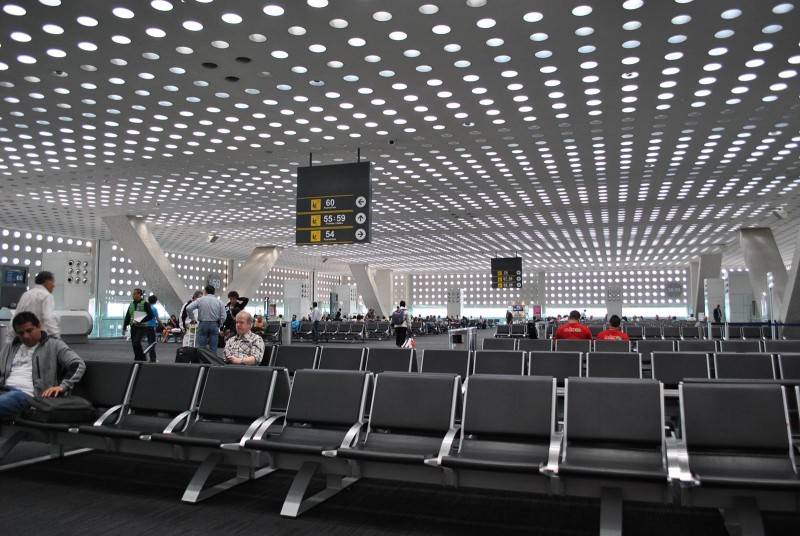 Public Transit There's plenty of public transit available in Mexico City for something approximating $0.30 per ride. The bus offers a direct shot into downtown without needing to transfer from the international Terminal 2. You have to pay with a fare card, but there's a vending machine out on the curb. Alternatively, the Metro can be accessed from the far end of Terminal 1. The two terminals are connected by a monorail, simply show the guard your recent boarding pass to get on. This is the airport site detailing transportation options. It defaults to "Taxi", and maybe you should too. Roughly $10 or P150 to downtown during normal hours isn't that expensive. If your Spanish skills are on point, you can typically also buy fare cards for all forms of public transit from convenience stores such as Circle K or 7-11 both of which have outlets located in the airport. Key phrase: Quiero comprar una tarjeta para pagar el Metrobus. You'll be asked how much you want to put on the card. I think P50 or 10 rides is a good start and sometimes there is a fee of P30 to buy the card itself. Visit the Metrobus site for maps and more info on the route. Taxis: When catching a taxi from the airport, the process is highly formalized to prevent gouging. The cost overall is higher, but it is predictable and safer as only authorized drivers are permitted. You'll visit a taxi stand to buy a voucher (you can haggle if you think the price is high) then present the voucher to the driver as payment. 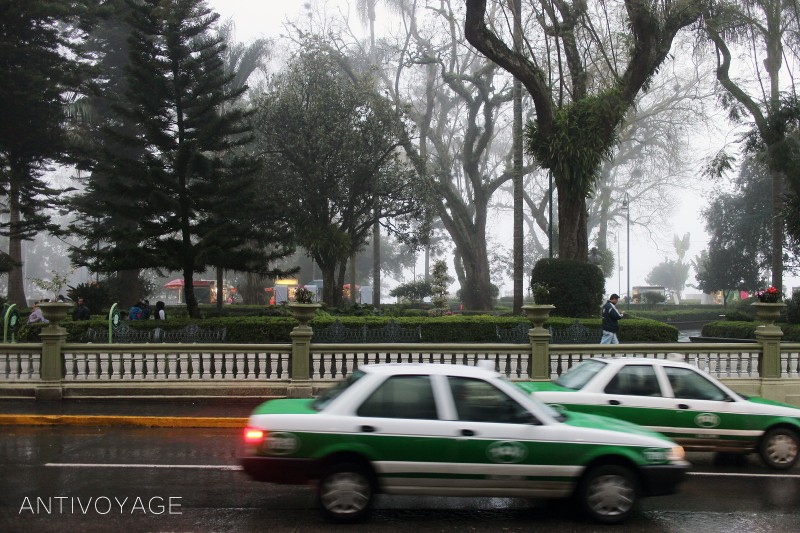 Long Distance Bus: If you stay the night or for a couple of days to acclimatize at Mexico City's 2,250 m of elevation (you'll feel it!) TAPO, the main eastern bus terminal has many more options for whisking you towards Puebla where you can connect to regional busses to Tlachichuca at their CAPU station. Bear in mind that Puebla has two terminals: a small "Executive" terminal closer to the city center and an airport-scale terminal that's farther out of town at CAPU. TAPO in Mexico city does not have a website, but a useful bus schedule publisher posts maps and keeps up to date contact info. (in Spanish---don't forget Google Translate). CAPU in Puebla does have a website and it kind of needs one. I found the arrangement a little baffling until I created a mental map for myself. The terminal consists of two nested 'C' shapes, one inside the other. Arrivals are to the inner 'c' and departures are from the outer 'C', which connects to the street and a grand ticketing hall. I hope that helps. Finally, Ticketbus is hands down the most comprehensive site for inter-city routes. They're not so great for regional routes. Just because they don't have it on their site doesn't mean the route doesn't exist. Google is your friend. :-) 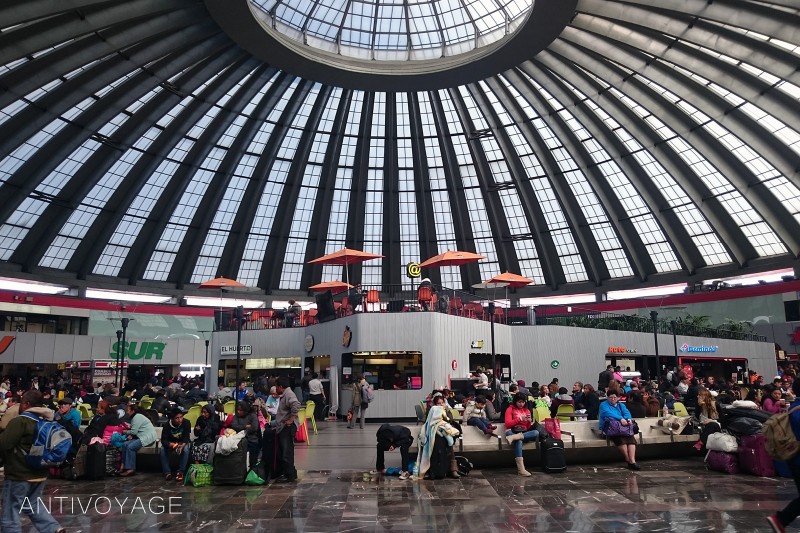 Onward from Puebla's CAPU -- Regional Bus: To purchase onward transit from CAPU, go queue up at the 'AU' or Autobuses Unidos, a common 2nd class bus line. See photo for the sign you need to look for. Here's the thing: you COULD just go pay cash to the driver, BUT first you'd have to find the bus and then you wouldn't be guaranteed a seat. If you're traveling around Christmastime, lines will be bonkers and you may want to roll the dice. The gate these buses depart from changes so your best bet is to start asking questions, key phrase: ¿Me puede decir como llegar al camión que sale a Tlachichuca?" (Mexican Spanish commonly substitutes camión (truck in Castillian) for autobús (bus). 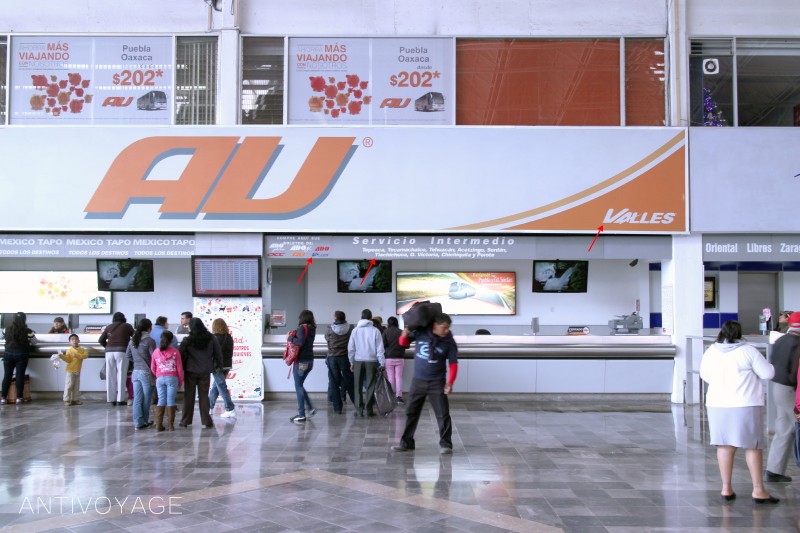 If the lines aren't too long, its worth having a reserved seat and you'll have the added benefit of speaking with a person whose job it is to tell you where to catch the bus. Here's where that can get confusing: as someone who studied Spanish pretty intensively since high school the directions come out rapid fire and there are some key vocabulary and spatial queues you'll need to listen for. There's hearing and then there's understanding.
Pay toilets: I was offended! Pay to use the toilet? I would never stoop so low as to PAY to use the toilet! Where's the Starbucks? Here's the thing, when you convert a basic human need from an obligatory cost center for businesses to provide into a profit-making service, incentives are aligned to make them nice. It's kind of weird, but typically for no more than P5 or $0.30 you can visit a pay toilet that is spotlessly clean. One funny aspect: the attendants are usually women in both the Men's and Women's rooms. Remember to pick up toilet paper from the big dispenser at the entrance. The nice thing about having the attendant present is they were able to watch my backpack without carrying it into a cramped stall. Off-road travel to the hut--the last 24 km: Once you arrive in Tlachichuca, negotiating a 4x4 ride up to the hut can be a little wild and woolly. Prices are all over the place, but from my experience P1000 for a truck load or P250 per person are down the middle. The taxi to Hidalgo should cost around P130. Typically taxis charge something around P5 per minute outside of Mexico City. For longer rides such as the thirty minutes it will take the driver to get to Hidalgo and back it's customary to pare this back a bit, so P130, a 15% discount is ok. Locals might be asked to cover only the way there for P75-100, but we're not talking big bucks either way, and there's no reason to be stingy. Take care of the people helping you: In Tlahchichuca I preferred the Casa Blanca restaurant on the northwest corner of the plaza, but ate tacos at Yilber one night. One of the chefs was impressed I'd flown into Mexico by plane. I was initially confused, but you realize this community is pretty small and isolated aside from the climbers coming through. === Stay in touch! I wrote a book and I'd be happy to answer any questions you may have on your trip planning, climb or any other aspect of this AWESOME peak. I value your feedback. I can be found on twitter @antivoyages and will be setting up a website in the coming weeks. Safe climbing, -A |
| Comments or Questions | ||||||
|---|---|---|---|---|---|---|
|
Caution: The information contained in this report may not be accurate and should not be the only resource used in preparation for your climb. Failure to have the necessary experience, physical conditioning, supplies or equipment can result in injury or death. 14ers.com and the author(s) of this report provide no warranties, either express or implied, that the information provided is accurate or reliable. By using the information provided, you agree to indemnify and hold harmless 14ers.com and the report author(s) with respect to any claims and demands against them, including any attorney fees and expenses. Please read the 14ers.com Safety and Disclaimer pages for more information.
Please respect private property: 14ers.com supports the rights of private landowners to determine how and by whom their land will be used. In Colorado, it is your responsibility to determine if land is private and to obtain the appropriate permission before entering the property.
